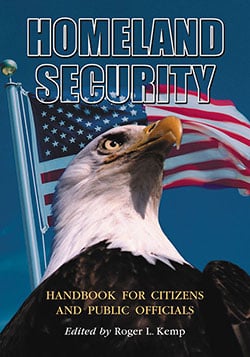Homeland Security Handbook for Citizens and Public Officials
$39.95
In stock
About the Book
Although the phrase “homeland security” evokes images of cataclysmic terrorist attacks, and a massive web of government agencies, it also comprises the prevention, mitigation, response and recovery from any disaster, man-made or natural, from the grassroots level to the federal government. Since September 11, federal, state and local governments, national organizations, and citizens have undertaken many diverse initiatives to enhance American emergency preparation and response programs. This handbook collects essays documenting numerous best practices in homeland security from throughout the United States since the attacks of September 11, 2001. The essays, by many experts (including former Department of Homeland Security Secretary Tom Ridge), describe case studies from the municipal level to the federal government. Also covered are the history and future of homeland security. Appendices include lists of acronyms, internet resources, American Red Cross and Homeland Security Advisory System recommendations, FEMA regional offices, and state offices and agencies of emergency management.
About the Author(s)
Bibliographic Details
Edited by Roger L. Kemp
Format: softcover (7 x 10)
Pages: 269
Bibliographic Info: appendices, index
Copyright Date: 2006
pISBN: 978-0-7864-2432-0
Imprint: McFarland
Table of Contents
Preface 1
PART I: INTRODUCTION TO HOMELAND SECURITY
1 Civil Defense, Emergency Management, and Homeland Security 7
PART II: HOMELAND SECURITY FOR CITIZENS AND PUBLIC OFFICIALS
2 Access Control Systems Improve Building Security 13
3 Air Transportation, Improved Safeguards, and Homeland Security 16
4 American Red Cross Disaster Preparedness Guidelines 22
5 Automated Public Notification Systems Enhance Communications with Citizens 27
6 Building Design Improves Public Safety 32
7 Communications Among First Responders 35
8 Community Emergency Response Teams Provide Vital Emergency Services 39
9 Community Volunteers as Homeland Security Stakeholders 46
10 Coordination Between the Public and Private Sectors in the Field of Homeland Security 49
11 Critical Infrastructure Assessment and Homeland Security 52
12 Department of Homeland Security: Its Proposed Structure and Operations 56
13 Dispatch Center Services and Emergency Responses 63
14 Early Warning Group Results from Public-Private Cooperation 68
15 Emergency Response Plans and Homeland Security 73
16 Entrepreneurial Resources and Homeland Security 75
17 Evacuation Procedures for Buildings 80
18 Family Planning Recommendations by the Department of Homeland Security 89
19 Fatalities Management and Homeland Security 92
20 Federal Emergency Management Agency’s Role in Terrorism Preparedness and Response 97
21 GIS Improves Emergency Coordination and Response 100
22 Health-Care Systems and Homeland Security 103
23 High-Rise Structures, Disasters, and Public Safety 107
24 Homeland Security Advisory System and National Threat Conditions 110
25 Hospitals Must Prepare for Possible Bioterrorism Attack 115
26 Infrastructure Protection Is Enhanced Through Technology and Cooperation 118
27 Law Enforcement’s Response to the War on Terrorism 124
28 Multi-Agency Cooperation Enhances Homeland Security Practices 130
29 Municipal Electronic Operations and Disaster Planning 135
30 Mutual Aid Agreements Build Local Disaster-Response Capacity 137
31 National Incident Response Plan: A Comprehensive Interagency Approach to Emergency Management 140
32 Neighborhood Watch Programs and Homeland Security 143
33 Personal Identification Technologies, Practices, and Homeland Security 147
34 Police Services and Homeland Security Practices 153
35 Presidential Commission Advises on Ways to Protect the Infrastructure 160
36 Private Sector’s Response to the War on Terrorism 165
37 Professional Standards Recommended by the National Fire Protection Association 168
38 Public Information During a Crisis 173
39 Public Works Departments as Emergency Responders 176
40 Responsibilities for Homeland Security: Federal and Local Governments 181
41 Security and Emergency Response Improved Through Public-Private Cooperation 184
42 Statewide Guidelines by the President’s Homeland Security Advisory Council 187
43 Stress Management for Firefighters 194
44 Stress Management for Police Officers 199
45 Teledoctor: A New Concept in Emergency Preparedness and Response 205
46 Terrorism Fact Sheet by the Federal Emergency Management Agency 210
47 Threat Condition Orange: Common Sense Measures to Safeguard Your Community 214
48 Understanding Terrorists and Terrorism 218
49 U.S. Attorney’s Office and the Anti-Terrorism Advisory Council 222
50 Vehicular Safeguards and Homeland Security 224
51 Volunteerism and Emergency Preparedness 230
PART III: THE FUTURE OF HOMELAND SECURITY
52 Homeland Security, Civil Liberties, and the Future 235
Homeland Security Acronyms 239
Homeland Security Internet Resources 241
American Red Cross, Homeland Security Advisory System Recommendations 243
Federal Emergency Management Agency Regional Offices 247
State Offices and Agencies of Emergency Management 248
About the Editor and Contributors 253
Index 255
Book Reviews & Awards
“useful”—ARBA.





